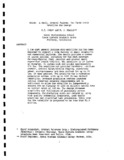ORION: A Small, General Purpose, Low Earth Orbit Satellite Bus Design
| dc.contributor.author | Fuhs, A.E. | |
| dc.contributor.author | Mosier, M.R. | |
| dc.date | 10/01/87 | |
| dc.date.accessioned | 2013-11-13T01:03:31Z | |
| dc.date.available | 2013-11-13T01:03:31Z | |
| dc.date.issued | 1987-10 | |
| dc.identifier.uri | https://hdl.handle.net/10945/37318 | |
| dc.description | Publication: AIAA/USU Conference on Small Satellites | en_US |
| dc.description | Technical Session IV: Small Satellites - Systems/Buses | en_US |
| dc.description.abstract | A low cost general purpose mini-satellite bus has been designed to support a wide variety of small scientific and commercial payloads. The design provides a number of launch options, including the new NASA extended Get-A way-Special (GAS) canister and several small expendable launch vehicles. The satellite is 19 inches in diameter, 35 inches high and weighs approximately 270 lbs. The satellite bus provides telemetry, attitude control, orbital boost/station keeping, electrical power, microprocessor and data storage for up to 50 lbs. of user payload. The satellite has a hydrazine propulsion system, with up to 2600 ft/sec delta-v capability. On-board propulsion reduces launcher orbital insertion accuracy requirements and is sufficient to allow the satellite to independently achieve 800 run circular or 2200 run elliptic orbits from an initial orbit of 135 run. The design stresses simplicity and utilization of previously proven components. Manufacturing costs are reduced by using high quality commercial components, good design practices and simplified test procedures. Total cost for the satellite is projected to be less than $1.5 million. | en_US |
| dc.rights | This publication is a work of the U.S. Government as defined in Title 17, United States Code, Section 101. Copyright protection is not available for this work in the United States. | en_US |
| dc.title | ORION: A Small, General Purpose, Low Earth Orbit Satellite Bus Design | en_US |





